 |
 |





 |
 |
 |
 |
 |
 |
Traffic camera boosts security at U.S., Canadian border rail bridge
|
 |
 |
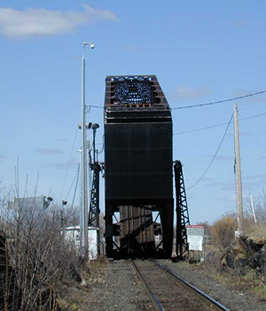 |
A surveillance camera
was installed on April 9 at the Ranier railroad crossing between Canada
and the United States. Customs inspectors two miles away at International
Falls can monitor rail traffic more efficiently. Photo by Bill Gardner
|
Mn/DOT surveillance cameras usually watch Twin Cities highway traffic, but
a similar installation near International Falls provides another set of eyes
to increase security at a busy border rail crossing.
The U.S. Customs Service requested the camera to heighten security as part
of an overall upgrade initiated a couple of years ago. An average of 15 Canadian
National Railroad trains cross the bridge daily, making it the third busiest
rail crossing between the United States and Canada. The railroad crossing between
Ranier, Minn., and Fort Frances, Ontario, ranks only behind bridges at Detroit
and Buffalo in traffic levels.
The new camera gives Customs inspectors an easier, more effective way to monitor
the bridge and trains. Previously, inspectors climbed onto the roof of the rail
station at Ranier to observe rail traffic using the 500-feet-long lift bridge,
said Customs official Craig Williams.
Bill Gardner, Freight Section director, and Bob Gale, Freight planning manager,
Office of Freight, Railroads and Waterways, recently inspected the installation
funded by the Federal Highway Administration and the railroad. The FHWA paid
80 percent of the $113,000 cost; the railroad contributed the remainder.
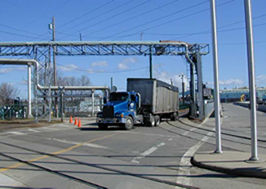 |
|
A truck crosses the
bridge between Canada and the United States at International Falls. Trucks
and rail cars share the center section because it can accommodate the
heavier load. Customs inspectors say 200,000 to 300,000 vehicles cross
the bridge annually. Photo by Bill Gardner
|
Plans also include installation of x-ray equipment within the next 18 months
to inspect rail cars at the Ranier bridge.
Within 18 months, the United States and Canada will require surveillance cameras
at nine more border rail crossings. In addition to the Ranier crossing, there
are rail border crossings between Minnesota and Canada at Noyes, Baudette, Warroad
and International Falls.
A few miles away, the International Falls border crossing includes rail and
highway transport. The bridge has three separate sections—one on each side for
cars going in each direction and a middle section for trains and heavy trucks.
Approximately 200,000-300,000 vehicles each year cross the border at International
Falls.
By Sue Stein
|
back

|
 |
Minnesota joins other states, Canadian provinces in signing agreement
|
 |
 |
Commissioner Elwyn Tinklenberg and other Northern Great Plains leaders signed
a collaboration agreement on May 14 in Minneapolis. Representatives from Iowa,
Minnesota, Nebraska, North Dakota, South Dakota, Saskatchewan and Manitoba agreed
to work together on transportation and economic issues.
A three-year study managed by Northern Great Plains Inc. found that trade within
the Great Plains regions grew by 571 percent between 1992 and 1997, while goods
and services exported from the region grew by only 91 percent.
Northern Great Plains Inc. received funding in 1999 from the Federal Highway
Administration to analyze current and future opportunities for regional and
international trade development and to match those opportunities with regional
transportation needs.
Copies of the report are available at www.ngplains.org.
|
back

|
 |
Agency gears up for second phase of Shaping Our Future
|
 |
 |
Great progress has been made to date in planning the change efforts for Shaping
Our Future, according to Deputy Commissioner Doug Weiszhaar.
"We will continue those efforts as we move to Phase II of Shaping Our
Future, which involves devaluated functions that were not reviewed in Phase
I or remained centralized," Weiszhaar said in a May 2 memo to managers.
"As I’ve said before, Shaping Our Future is not a one-time, temporary effort.
Shaping Our Future is an ongoing effort to create a new organization that is
successful in the new environment."
Read more by clicking on the May 2 memo on the Commissioner’s
Office site. See also the Shaping
Our Future Web page for other updates.
|
back

|
 |
Streamlining initiatives enter mainstream
|
 |
 |
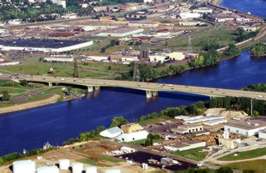 |
The Wakota Bridge project
in Newport is one of Mn/DOT’s streamlining initiatives.
|
Mn/DOT’s streamlining efforts will soon make a difference where it matters
most—results that provide relief from traffic congestion or improve mobility
and safety.
Drivers in long queues waiting to cross the Wakota Bridge in Newport will have
a shorter wait when the new I-494 bridge gets built there, thanks in part to
the shortened construction plan content requirements that emerged from Mn/DOT’s
streamlining initiatives.
When District 6 rebuilds 11 miles of Hwy 52 through Rochester, motorists will
have a safer, less-congested route six years earlier than originally planned,
due in part to using the new design-build process, another streamlining practice
used on selected projects throughout the department.
The design-build process is one of the hallmarks of Mn/DOT’s effort to simplify
and accelerate the highway and bridge construction process by overlapping design
and construction.
The two projects represent Mn/DOT’s streamlining process joining the mainstream
within only a few years of initiating the design-build process.
The department’s commitment to streamlining activities started in January 2001
when the Project Delivery Streamlining Team was created. Although the team completed
its work, efforts continue to implement many of its initiatives.
Streamlining also comprises an integral part of the department’s Moving Minnesota
initiative and Shaping Our Future strategy.
Mn/DOT now uses various streamlining techniques to accelerate planning and
completion of projects such as the Hiawatha LRT, the Hwy 23 bypass at Paynesville,
rebuilding of Hwy 169 near Lake Mille Lacs and widening of Hwy 100 in the western
Minneapolis suburbs.
The momentum generated by the streamlining task force also affects other project
development aspects, notes Del Gerdes, former streamlining team director who
recently resumed his duties as director of Technical Support.
"In most districts, we have now placed highway pre-construction activities,
such as pre-design and final design, under one project manager," he said.
"That means there is one focal point which improves project coordination
and communication and speeds project completion."
Other changes include an enhanced project and program tracking system, improved
contract consulting methods and major modifications in acquiring right-of-way
and other land management practices.
Streamlining led Mn/DOT to decentralize many land management functions and
to employ the "footprint" process to plan right of way acquisition.
The footprint process uses highway design parameters to determine the preliminary
limits of needed properties and start the right-of-way process sooner.
Gerdes said Mn/DOT secured agreements with the Department of Natural Resources
and the Minnesota Pollution Control Agency to assign agency staff to help directly
with major projects such as bottleneck and corridor improvements.
"Having DNR and PCA staff work in liaison roles will help smooth out bumps
in the process and also helps them learn what we do," Gerdes said.
Gerdes said an attitude shift underlies the growing acceptance of Mn/DOT’s
streamlining initiatives. Project and support staff, he said, know completing
projects more quickly is crucial to meet the state’s rapidly growing transportation
needs.
"We are under the mandate of the Moving Minnesota initiative to deliver
our increased highway construction program on time with quality and within budget,"
he said. "Incorporating streamlining initiatives into our processes helps
ensure our capability to do that."
Dick Stehr, Program Support Group director and leader of Mn/DOT’s change management
efforts, explains that the streamlining process is an integral part of the Moving
Minnesota initiative and the Shaping Our Future efforts.
"The streamlining philosophy supports delegating much of Mn/DOT’s decision-making
to the districts and the Metro Division," he said. "This means placing
authority and trust with the districts and Metro to make sure that a final plan
or a consultant contract is correct, for example, or to get input from specialty
offices at the beginning of the process."
Stehr acknowledges that the changes needed to fully implement streamlining
are not easy ones.
"We are making major changes in areas such as Maintenance, Land Management
and Traffic Engineering that require moving resources—including people—into
new locations or reporting arrangements," he said. "And even when
process improvements are relatively minor, they are part of a network of activities;
it’s often very difficult to cut through a myriad of obstacles to untie knots
that are 40 years old."
Stehr said that while putting streamlining and other process improvements in
effect is arduous, the potential benefits outweigh the risks.
"The risk is worth it because of the greater speed and efficiency with
which we can complete projects. Mn/DOT people are committed to getting the work
done," he said. "Streamlining is one way to speed process review,
increase efficiency and enable decision-making to occur at the most logical
levels in the organization."
By Craig Wilkins
|
back

|
 |
Stehr appointed Program Support Group director
|
 |
 |
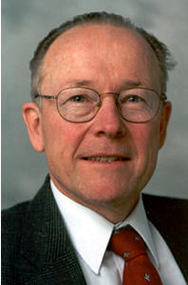 |
Dick Stehr is the new
Program Support Group director.
|
Deputy Commissioner Doug Weiszhaar May 15 announced the appointment of Dick
Stehr as Program Support Group director. Stehr has been serving as acting director
since January in addition to leading the department’s change management efforts
for the Shaping Our Future initiative.
"During this time, his leadership and commitment to making Mn/DOT work
better to meet our program goals have proven that he is the right person to
lead the Program Support Group and provide the vision for its future,"
Weiszhaar said.
Stehr has worked for Mn/DOT since 1976 in various management roles, including
most recently as director of Program Delivery and as Metro division engineer.
Before coming to Mn/DOT, he worked eight years for the California Department
of Transportation.
Stehr’s office is on the 4th floor, Transportation Building. He can be reached
at 651/296-3156.
|
back

|
 |
Tinklenberg leads national effort on Intelligent Transportation Systems
|
 |
 |
Commissioner Elwyn Tinklenberg testified May 10 before members of the U.S.
Senate Environment and Public Works Committee in Washington, D.C. He was invited
to address the committee as a leader in the national effort to implement Intelligent
Transportation Systems, which include 511, road and weather information and
congestion relief technology.
"ITS has emerged from being an end in itself to being a critical means
for achieving a broader set of goals—including capacity, safety, security and
reliability—in serving transportation users," Tinklenberg said in his remarks.
"ITS can also play an important role in ensuring the security of America’s
transportation system and in facilitating post-disaster emergency response and
evacuation technologies.
"The goal is to invest once to achieve maximum utility for the highway,
transit, public safety and emergency response communities as they serve the
public and user."
Congress is looking at ITS as it prepares to reauthorize the federal transportation
funding bill. The American Association of State Highway and Transportation Officials
estimates funding needs for ITS initiatives nationally at $142 million a year.
Click here to read the news
release, testimony and fact sheet.
|
back

|
 |
New system creates cyber ‘library’ of transportation information
|
 |
 |
Say you’re looking for a specific right-of-way map or information on a state
project but can’t find a paper copy of it. There’s still hope: many of these
types of documents—and others—are beginning to be available electronically through
Mn/DOT’s new Web-based document management system called CyberDocs.
Since April 2001, the department’s electronic document management system implementation
team has been busy setting up the central infrastructure and coordinating the
rollout of CyberDocs to a few pilot areas.
"Think of the system as a kind of electronic library that stores maps,
pictures, plans—virtually anything that is in an electronic format," said
Kay McDonald, Information Resource Management and project manager. Currently,
the "library" contains more than 100,000 documents, including several
thousand right-of-way maps.
And like a library, CyberDocs has an index that’s searchable in a number of
ways, including by author, document type, key words, state project number, trunk
highway number and parcel/location identifier. This makes it easy to locate
documents in seconds, McDonald said.
"Electronic document management is a tool for managing the life cycle
of a document," she said. "The idea is to make information more shareable
with others, while maintaining the integrity and security of the original document."
The Mankato, Rochester and Willmar districts, as well as Metro Division, Bridge
and Land Management are implementing the system using documents and data they
create or collect. Metro Division, for example, focuses on capturing all documents
related to Program Delivery (Planning, Design, Right of Way, Water Resources,
Surveys, Materials and Construction), Traffic Engineering, Maintenance and State
Aid.
According to Karen King, Metro Division project manager, the document management
system will speed the transition from paper processes to electronic processes.
"The document management system has been configured so that everyone in
Mn/DOT can use their Web browser to log on as a guest user (for anonymous access)
and view documents that do not have security restrictions. That's very important,"
King said.
"If our goal is to share documents, then they must be easily accessible
by everyone. Metro groups believe it is in the best interest of Mn/DOT as a
whole to change their processes, store their documents solely in the document
management system, and then direct others to access those documents via the
document management system so it can become a ‘trusted source’ of transportation
information," she added.
Luke Van Santen, chair of Metro’s Electronic Document Management Steering Committee,
agrees.
"This is a first step in really streamlining our business processes,"
he said. "We’re getting people to think about getting all their information
from a single source instead of maintaining separate (and usually redundant)
information, which will go a long way in making Mn/DOT more efficient."
McDonald said that as the project ends, the project team is in the process
of identifying future areas of implementation. If you have a potential business
need for document management within your area, contact McDonald via GroupWise
or at 651/296-8467 for more information.
If you are not a current pilot user, you can log into the system as a guest
and view documents that guests may access. Go to http://metrodocs/cyberdocs,
click on the Guest Log In button, and enter your search criteria. Note: you
may have to switch to the "Master Search form" available in the pick
list at the bottom of the page.
|
back

|
 |
Metro Division employees respond quickly to smooth out sticky situation on I-35W
|
 |
 |
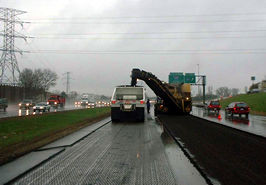 |
A sealant failure on
northbound I-35W between Roseville and Blaine on April 18 created a sticky
situation for motorists and Mn/DOT alike. Employees from Metro maintenance,
freeway operations, traffic engineering, materials and construction coordinated
efforts and worked extra hours to ensure that the repairs were made in
record time, according to Bev Farraher, Metro Division maintenance operations
engineer. Photo by Kent Barnard
|
After a crack sealant used for repairs on I-35W failed during the afternoon
rush hour on April 18, Metro Division staff went into overdrive to start emergency
repairs and resurfacing.
By May 14, crews completed most of the repairs in spite of an outpouring of
uncooperative weather.
The sealant failed when it became soft in the afternoon high heat and humidity.
Motorists who drove through the area on northbound I-35W found the sticky sealant
flying into the air and sticking to the tires and bodies of their vehicles.
The material was placed in the roadway late last fall during a routine crack-sealing
maintenance operation. Temperatures in the 90s and rain during the middle of
April apparently triggered the failure, according to Mn/DOT Metro Division Maintenance
officials.
An investigation into the problem, which included testing the material at Mn/DOT’s
Materials and Research Laboratory in Maplewood, determined that while the sealant
met department specifications, it did not perform properly. The contractor also
met the requirements of the contract and specifications.
Employees from maintenance, freeway operations, traffic engineering, materials
and construction coordinated efforts and worked extra hours to deliver the contract
in record time, said Bev Farraher, Metro Division maintenance operations engineer.
"Rising to the challenge, maintenance forces responded quickly to the
sealant failure on April 18. The best plan for corrective action was determined
the following day. Quick action also produced a package for competitive bid
in time to let the project the following Friday," she said.
Emergency resurfacing began Monday evening, April 29, on the northbound lanes
of the interstate between Hwy 36 in Roseville and Lake Drive (Anoka County Road
23) in Blaine. The aggressive, 15-day schedule meant long hours for Mn/DOT construction
employees and the contractor’s crew. All-night closures each weeknight between
Hwy 36 and I-694 allowed for increased productivity and safer working conditions.
While motorists have experienced congestion and delays, the project went smoothly,
said Tom Krier, project supervisor. In addition to restrictions on work during
rush hours, the rain provided an added challenge. Milling of the roadway surface
continued through the rain, but paving was suspended during downpours.
Through Tuesday, the state mailed out nearly 300 claim forms for damage from
the tar. Among the 88 claims received, amounts claimed range from $13.37 for
a can of solvent to $1,400 for damage to a motor vehicle. Many other motorists
have carried out clean-up operations on their own. Most motorists who called
have been furious, but they calm down after being reassured that their concerns
will be handled fairly, according to Gerry Heroff, tort claims investigator.
Heroff adds that legitimate claims for damage will be handled on a case-by-case
basis.
Although the sealant failure occurred without warning, Farraher said, the results
showed that Mn/DOT was able to rise to the challenge.
"This was an amazing situation, resulting in an amazing project that was
achieved by amazing people," she said.
By Kent Barnard
|
back

|
 |
New Willmar facility improves service, raises public awareness for transit use
|
 |
 |
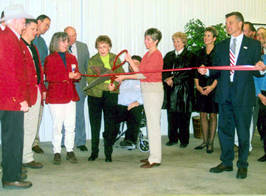 |
Officials from Mn/DOT,
Kandiyohi County and the city of Willmar gathered on May 9 to dedicate
the newly completed Kandiyohi Area Transit service facility in Willmar.
Photo by Sandy East
|
Officials from Mn/DOT, Kandiyohi County and the city of Willmar gathered on
May 9 to dedicate the newly completed Kandiyohi Area Transit service facility
in Willmar.
The new building accommodates eight buses, the dispatch office and a maintenance
area. The facility cost $360,000, said Beverly Herfindahl, Willmar District
transit coordinator. Mn/DOT allocated $255,000 for the facility; the county
funded the remainder. The city of Willmar provided trees and arranged for a
group of high school students to plant them during Arbor Week. City maintenance
employees will also complete landscaping the new site.
KAT was created in 1999 when the former Willmar Heartland Express service was
expanded to serve all Kandiyohi County residents. Herfindahl said the new facility
will help improve service and raise the awareness of transit options for county
residents.
KAT offers dial-a-ride service from 6 a.m. until 10 p.m. Monday through Friday.
"By having all the staff in one location, the facility helps deliver better
service and will give KAT a more convenient location and a more visible presence
in the area," Herfindahl said.
|
back

|
|
 |
|



